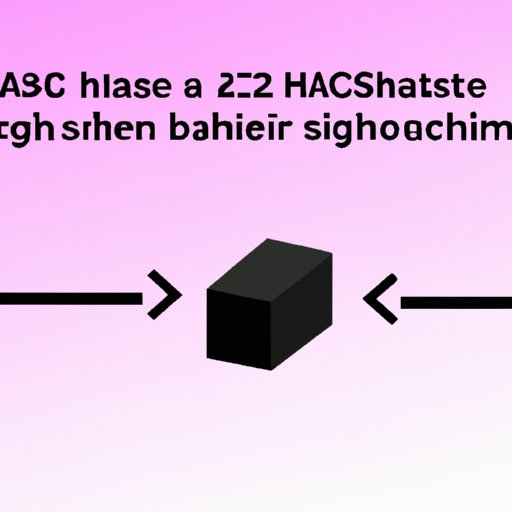Introduction
Hashing is a fundamental component of blockchain technology that enables secure storage and transmission of data. In this article, we’ll explore what hashing is, how it works, and why it is so important for blockchain technology. We’ll also look at the different types of hashing algorithms, their limitations, and how they are used in consensus mechanisms and smart contracts.

Explaining Hashing in Blockchain: A Comprehensive Guide
Before we dive into the specifics of hashing in blockchain, let’s start with a basic definition. Hashing is the process of taking a set of input data and producing a fixed-length output known as a hash or digest. This output is generated using an algorithm that is designed to be one-way, meaning that it is practically impossible to reverse engineer the original data from the hash.
What is Hashing?
Hashing is a mathematical process that converts any type of data into a unique string of characters known as a hash. Hashes are generated by passing input data through a cryptographic function or algorithm. The output of the function will always be the same length, regardless of the size of the input data. This makes hashes ideal for verifying the integrity of data. For example, if two files have identical content, they will produce the same hash, but if even one character is changed, the resulting hashes will be entirely different.
How Does Hashing Work?
The process of hashing involves taking a piece of data (e.g. a file, message, transaction, etc.) and passing it through an algorithm that produces a unique and deterministic output. The output of the algorithm is referred to as a “hash” or “digest”. The structure of the output is determined by the algorithm used; some algorithms may produce hashes of a fixed length while others may produce hashes of varying lengths. The output of the algorithm should always be the same length, regardless of the size of the input data.
Benefits of Hashing in Blockchain
Hashing has many benefits when used in a blockchain system. First, it can be used to verify the integrity of data since any change made to the data will result in a different hash. This ensures that data cannot be modified without detection. Second, hashing is a key component of blockchain security since it helps ensure that data stored in the blockchain is not tampered with or corrupted. Finally, hashing can help improve the efficiency of blockchain systems since it allows for faster validation of transactions.
The Power of Hashing: How it’s Used in Blockchain Platforms
Now that we’ve explored what hashing is and how it works, let’s take a closer look at how it is used in blockchain platforms. Hashing plays a key role in ensuring the security and data integrity of blockchain systems. It is also used to verify transactions and improve the scalability and efficiency of the network.
Security and Data Integrity
Hashing is used to ensure the security and data integrity of blockchain systems. Since every block in a blockchain must contain the hash of the previous block, any attempt to modify the data in a block will result in a different hash being produced. This makes it difficult for attackers to modify data without detection, thus improving the overall security of the system.
Verification of Transactions
Hashing is also used to verify transactions on the blockchain. When a transaction is broadcast to the network, all nodes must validate the transaction by computing its hash. If the hash matches the expected value, then the transaction is considered valid and can be added to the blockchain. This ensures that only valid transactions can be added to the blockchain.
Improved Efficiency and Scalability
Finally, hashing can help improve the scalability and efficiency of blockchain networks. By using hashes to verify transactions, the amount of data that needs to be stored on the blockchain is significantly reduced. This reduces the strain on the network and improves its overall performance.

Hashing in Blockchain: What You Need to Know
Now that we’ve discussed the basics of hashing in blockchain, let’s take a closer look at the different types of hashing algorithms and their limitations.
Types of Hashing Algorithms
There are several different types of hashing algorithms that are used in blockchain systems. The most popular algorithms include SHA-256, RIPEMD-160, and MD5. Each algorithm has its own advantages and disadvantages, so it’s important to choose the right one for your application.
Limitations of Hashing in Blockchain
Although hashing is an integral part of blockchain technology, it is not without its limitations. For example, hashing algorithms can only produce a fixed-length output, which means that larger inputs will result in longer hashes. Additionally, some hashing algorithms can be vulnerable to attacks, such as brute force attacks or collision attacks. It is important to choose the right algorithm for your application to ensure the security of your data.
Unpacking the Complexity of Hashing in Blockchain Networks
In addition to its use in verifying transactions and ensuring data integrity, hashing is also used in other aspects of blockchain technology. Let’s take a closer look at two of the most important uses of hashing in blockchain networks.
Consensus Mechanisms and Hashing
Hashing is essential for the operation of consensus mechanisms in blockchain networks. Consensus mechanisms are used to achieve agreement among all nodes in the network regarding the validity of transactions. The most popular consensus mechanisms, such as Proof of Work and Proof of Stake, rely heavily on hashing algorithms to generate consensus-based solutions.
Hashing and Smart Contracts
Hashing is also used in the execution of smart contracts on blockchain networks. Smart contracts are self-executing programs that run on top of a blockchain and allow users to exchange assets in a secure, trustless manner. Hashing algorithms are used to verify the integrity of the data stored in the smart contract before it is executed.
Conclusion
Hashing is an essential component of blockchain technology that enables secure storage and transmission of data. It is used to verify the integrity of data, verify transactions, and improve the scalability and efficiency of the network. Hashing is also used in consensus mechanisms and the execution of smart contracts. While hashing is a powerful tool, it is not without its limitations and users should take care to choose the right algorithm for their application.
(Note: Is this article not meeting your expectations? Do you have knowledge or insights to share? Unlock new opportunities and expand your reach by joining our authors team. Click Registration to join us and share your expertise with our readers.)
